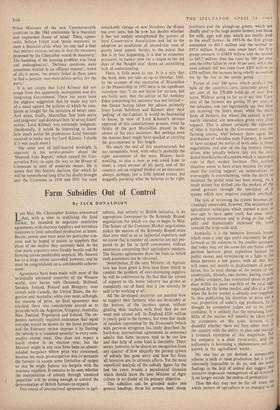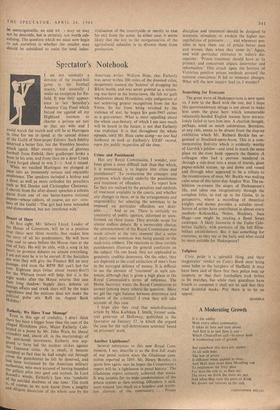Farm Subsidies Out of Control
• By JACK DONALDSON
LsT May Mr. Christopher Soames announced that, with a view to stabilising the food market, he intended to negotiate restrictive agreements with overseas suppliers and introduce measures to limit subsidised production at home. Bacon, cereals and meat were his particular con- cern, and he hoped to ensure to suppliers that share of the market they currently held. At the time many exporters were frankly hostile and the farming unions predictably sceptical. Mr. Soames has to a large extent succeeded, however, and he must be congratulated on a considerable achieve- ment.
Agreements have been made with most of the technically advanced countries of the Western world; over bacon with Denmark, Holland, Sweden, Ireland, Poland and Hungary; over cereals with Canada, the United States, the Ar- gentine and Australia; while over meat, althoUgh, for reasons of price, no final agreement was reached, there was considerable accord as to principle with the Argentine, Uruguay, Australia, New Zealand, Yugoslavia and Ireland. The ex- porters naturally required assurances that equal restraint would be shown by the home producer and the February review imposes it by limiting the subsidy to a `standard quantity' in every com- modity except meat. One does not expect a harsh review in an election year, but, the Minister might in any case have been an absent- minded bargainer where price was concerned, because his main preoccupation was to persuade the farmers to accept some limitation of output so that he might honour his bargain with the overseas suppliers. It remains to be seen whether the manipulation of subsidy through 'standard quantities' will be strong enough to control the determination of British farmers to expand.
This round of international agreements in agri-
culture, due entirely to British initiative, is an appropriate forerunner to the Kennedy Round, negotiations for which are due to begin in May. The failure of the Common Market negotiations makes the success of the Kennedy Round more than ever vital to us as industrial exporters, and we know that a number of countries are not pre- pared to go far in tariff concessions without assurances concerning their agricultural markets. The Soames agreements show the lines on which such assurances can be obtained.
Nevertheless, if the next Minister of Agricul- ture has been given a firm base from which to combat the problem of ever-increasing supplies, he will be confronted by the fact that the system of support to the home industry has grown so completely out of hand that it can scarcely be said to be working at all.
All the developed countries are puzzled how to support their farmers, who are invariably at the bottom of the incomes queue, without glutting their markets with food they do not want and cannot sell. In England £320 million is yearly paid to the farmers, but even that shade of opinion represented by the Economist (which with perverse arrogance has lately described the hard-won international agreements as nonsense) admits that farm incomes tend to be too low and that help of some kind is inevitable. There seems, however, to be almost no recognition from any quarter of how absordly the present system of subsidy has gone awry and how far from all intention are its ultimate effects. Yet the most superficial analysis of the subsidy figure for the last ten years reveals a paradoxical situation which should leave the next Minister of Agri- culture in no doubt of his primary objective.
The subsidies can be. grouped under two general headings, those for cereals, beef, sheep,
fertilisers and the plough-up grants, which are chiefly paid to the large arable farmer, and those for milk, eggs and pigs, which are chiefly paid to the small farmer. In 1955-56 the first group amounted to £61.7 million and the second to £97.1 million. Today, nine years later, the first group amounts to £180.9 million and the second to £63.7 million. One has risen by 200 per cent and the other fallen by over 30 per cent, wh:le the total subsidy bill has risen from £205 million to £320 million, the increase being wholly accounted for by the rise in the arable group.
Farms of over 300 acres. which produce the bulk of the country's corn, constitute about 5 per cent of the 270,000 holdings of over five acres. Without going so far as to say that 5 per cent of the farmers are getting 55 per cent of the subsidies, one can legitimately say that they are receiving the lion's share, while the main body of farmers, for whom the subsidy is pri- marily intended, are nowadays given very little support. This is almost certainly the opposite of what is intended by the Government and the farming unions, who' between them agree the distribution of subsidies each February. It seems to have escaped the notice of both sides to those negotiations and also of the big farmers them- selves, who proudly believe they are the inci- dental beneficiaries of a system which is necessary only to their weaker brethren. This curious situation seems to have arisen because the argu- ment for cutting support on commodities in over-supply is overwhelming, while the desire to maintain the global total has been strong. As a result money has drifted into the pockets of the cereal growers through the operation of a system which now requires complete overhaul.
The task of reviewing the system becomes in- creasingly unenviable, however. The revolution is agricultural techniques which seemed a year or two ago to have spent itself, has once more gathered momentum and in doing so has radi- cally and dramatically increased the trend towards the large-scale unit.
Ironically, it is the intensive livestock house, which even a year ago could reasonably 'he put forward as the solution to the smaller acreages, that today may set the scene for cut-throat com- petition between great capitalists backed by public money and terminating in a fight to the finish between a few giants, with all that this will mean, not merely in displacement of popu- lation, but in total change of the nature of the countryside. Already, one farmer, having created a public company, has announced plans to pro- duce within six years one-fifth of the total eggs required by the home market, and this at a time when the home market is already over-supplied. In thus publicising his intention to drive out 3 vast proportion of today's egg producers, he is thought by competent judges not to be over- confident. It is unlikely that the remaining four- fifths of the market will speedily be taken over by companies on this scale, because it is doubtful whether there are four other men in the country with the ability to plan and manage a livestock enterprise of this magnitude. But his company is a clear trend-setter, and the millionaire is becoming a phenomenon not un- known in the agricultural world.
No one has as yet devised a comparable scheme in milk or meat production, but it is not inherently impossible to do so, and the latest findings in the field of animal diet suggest that intensive large-scale management of all livestock is no longer outside the realms of probability.
Thus the day may not be far off when the whole pattern of agriculture is so changed as to be unrecognisable, an end wh may or may not be desirable, but is certainly not worth sub- sidising. The question which we must now begin to ask ourselves is whether the smaller man should be subsidised to resist the total indus- trialisation of the countryside or merely to ease his exit from the scene. In either case, it seems likely that the key to the reorganisation of the agricultural subsidies is to divorce them from production.







































 Previous page
Previous page